The natural resources industry takes a lot of criticism for being behind the times. Critics, both inside and outside of the industry, point to the slow adoption of already proven technologies as proof that the mining industry just doesn't "get it" when it comes to innovation.
There is much truth to this. In one area, however, the mining industry has always been ahead of the curve: collaboration. While other industries fought it out, for decades mining companies have been collaborating with NGO's, communities and suppliers to tackle broad industry challenges.
Traditionally, these collaborative projects have been funnelled through consortia like the Canadian Mining Innovation Council (CMIC), Commonwealth Scientific and Industrial Research Organisation (CSIRO), AMIRA International and the International Minerals Innovation Institute (IMII) which provide a legal framework for competitors to solve shared challenges, especially around socio-economic and sustainability issues.
Given that history of external collaboration, miners should have been cultural first adopters of one of the hottest trends in business: ‘open' or ‘collaborative' innovation.
Today, open innovation is a key strategic pillar of many of the world's leading companies. The term was first coined by Berkeley professor, Henry Chesborough, to describe the belief that firms should use external as well as internal ideas, paths and capabilities to develop and market their technology. The thinking was that knowledge which resided outside of the organisation could be useful to the firm and, by sharing risks and rewards, partners would develop more and better innovations, faster.
The concept had been around for about 60 years before Proctor & Gamble, in the late 1990's, decided to collaborate openly with the outside world to source 50% of its new product development projects. With this action, the open innovation movement was truly born.
Because the capital-intensive mining industry was a natural fit for open innovation, programmes quickly sprung up. In 2000, Rob McEwen at Goldcorp broke a golden rule and put all his company's geological data online, in essence sharing it with the whole world, and in 2008, Rio Tinto launched its Mine of the Future programme that sought to work with suppliers to develop new technologies.
In the last few years, AngloGold Ashanti's ATIC program and Vale's Base Metals Innovation Consortia, both of which Stratalis partners led, have built the largest open innovation consortia in the industry.
However, despite the natural fit, the culture of open innovation never sat easily with many mining companies. Early open innovation programmes saw many companies adopt combative and secretive positions with suppliers and technologies. Battles with collaborators over intellectual property rights slowed projects down at the expense of technology implementation. Companies remained highly siloed, barely collaborating internally, let alone well with the outside world.
With the last down-cycle, many programmes were terminated or halted, and the industry, once a pioneer, fell behind the rest of the business world.
This is a shame, because the mining industry is well suited for the practice. So it comes as good news that the industry has shown a renewed interest in open innovation.
Anglo American has recently launched an open forum initiative intended to develop technologies and operating models for the future. Companies like Rio Tinto and AngloGold Ashanti's ATIC, which never shut down operation, have continued to reinvest in their platforms. BHP is said to be looking at open innovation as a potential lever as it refreshes its technology strategy. Even at the local level, players like Gold Fields, have supported open innovation mining ‘hackathons' to develop new ideas.
There are some very practical reasons for this. For one, several years of cost-cutting have left capital-constrained mining companies without a means to grow their businesses or significantly improve productivity, safety or other measures of value. The high cost of technology development is another main reason.
According to Engin Özberk, senior technical advisor at the IMII, and former vice president of technology and innovation at CAMECO, said: "In certain major industries, like potash, base metals, iron production and oil and gas, open innovation has a lot of value, as is a very high-cost investment. With open innovation, you take smaller dollars and when you put them all together, you are doing big things. That is why people are in open innovation again."
In addition, the risks inherent in technology development call for diversification. As Rick Joyce, former group executive of innovation for Newmont Mining, puts it, "the big ticket projects are risky. If one company cannot foot the bill alone, that gives them incentive to develop the technology collaboratively and spread the risk."
Key steps
As the industry surges into a second wave of open innovation, it must take the right steps to increase its chances of success and longevity. In conjunction with industry leaders, we have discovered five key pillars that collaborative programmes, old and new, should be built upon.
While many companies participate in open programmes for better ideas, the challenge in open innovation is not in discovering good ideas. It is in properly aligning open innovation with the broader corporate strategy and in avoiding the pitfalls inherent with multiple suppliers, agendas and projects. Simply put, it is in moving from vision to execution. Ensuring that these five pillars exist could mean the difference between success and failure.
These are addressed below.
Clear technology strategy and vision
Many companies enter into open innovation programmes without having established a clear technology vision and strategy. The establishment beforehand of a clear long-term, multi-staged vision, including real metrics, milestones and well-defined innovation targets is a critical element in guiding a successful open innovation programme.
According to Joyce, "if you don't have your strategy defined as to where you want to be and where you want to move in the future and have that vision, you can do all the collaboration you want, but it is unfocused. You end up in a ‘cloud of innovation' with no true direction. Before you do any of those things, you need to have real goals to focus energy on - and understand how to focus the cloud on the strategic items."
Having a clear technology strategy is just as important as a vision. Within the confines of an open innovation programme, the technology strategy informs what areas to focus on, which are of competitive advantage, how intellectual property (IP) and investment will be managed, and what types of technologies the open innovation platform should focus on.
From the perspective of partners, this is critical. "The strategy and vision, say in a company like Glencore Xtstrata or Vale is different than what it was at Inco or Falconbridge" says Özberk. "Partners need to understand what the specific needs of the company will be and what their long-term goals and business models are in order to participate".
Defined role for open innovation
Companies need to acknowledge that open innovation is a tool within a broader innovation programme, not a cure-all for their technology development needs. Some challenges are best addressed with off-the-shelf solutions, or outsourced.
In some cases, using open innovation can harm a company's competitive position. Peter Kondos, senior director of strategic technology solutions at Barrick Gold, explains that: "open innovation should be applied with only one exception: for technologies that are at the heart of our competitive existence. If we spend decades investing in certain technologies, how open can the innovation be around this subject? We have protected these technology rights because it provides a competitive advantage."
According to Joyce, where to focus open innovation efforts is part of achieving the strategic goals of the company while balancing capabilities, risk and reward. "If you have the internal capabilities to do it and it's an advantage, you do it yourself," he explains.
Clear pathway for partners
Some suppliers feel a little ‘burned' by the last-round of open innovation. Many consortia started out strong, but failed to develop into profitable projects before the current down-cycle. In addition, suppliers have become savvier about open innovation and may have their own programmes in place.
In order for mining companies to attract consortium participants, they will need to do a better job of communicating a clear pathway forward and an attractive business opportunity for partners, starting with a clear vision.
Kondos explains: "you have to have a clear vision, accepted by all parties; otherwise there is no partnership, no collaboration." This vision includes clarity on how IP will be managed and where funding will come from.
According to John Thompson, former vice president of technology at Teck Resources, partners will also want commitment and clarity on how projects will be delivered. "Arguably, there has also been a lack of clarity on who will deliver the innovation - the mining companies, their equipment suppliers, or collaborative university-based research groups," he says.
Finally, suppliers will be seeking stronger assurances that innovation investment in conjunction with mining companies will lead to a market opportunity and sales within that mining company.
Drive to execution
Even with a clear vision, strategy and pathway, we have found that many programmes will generate interesting ideas but not lead to executable projects. Lack of visible results is the most obvious reason innovation programmes falter.
While there are a great many reasons for this, some things can be done in order to improve the chances of executable concepts and support:
- Quick wins build support. Innovation leadership should balance out short- and long-term projects to provide the operations, executives and suppliers with evidence that the programme will provide benefits.
- Shift from open to closed innovation. Once good ideas exist and have been prioritised by potential impact, risk, time to market and other factors, mining companies should quickly transition open ideation to defined project teams around high-value concepts and contracted partners. Leaving conversations open for too long loses momentum. As Kondos puts it: "the practical part of innovation is how fast you can take these concepts and ideas and move them towards producing value and results in your own challenge. You open the competition up and then systematically narrow it down through testing and evaluation".
- Technical team involvement. Most projects will be ‘owned' by supplier companies and are partially out of the control of the mining company. Involving engineering and technical expertise from both sides early in the process improves the relevance and prioritisation of concepts, increases prototyping speed and facilitates successful pilot testing.
Change management
Last but not least, open innovation programmes must recognise that as with all new things, technology adoption is a long-term effort and must be managed as a cultural change programme, with communications and change management considered early in the process.
Resistance from operations, lack of executive support, and changing priorities or frustration on the part of partners can kill initiatives. Open innovation programmes that focus on technology over people inevitably run into abandoned technology and eventually, abandoned programmes.
The challenge, according to Joyce, "is the cultural piece of innovation that some people forget to work on. All the portfolio management tools and graphs in the world miss the point; the cultural aspects of collaboration and getting people to work together are more important. Yes, you do need an infrastructure, you need the tools and processes, but you also need the cultural elements in order to be successful."
Conclusion
Open and collaborative innovation is getting a second chance within mining, and is poised to deliver on the promise of newer, safer and more profitable mining technology and operating models. With the help of experienced facilitation and by following some simple principles, mining companies can reap significant benefits and ensure open innovation's place within their toolkit.
The Stratalis Group is a full-service strategy and innovation consultancy and a leader in open innovation for the resources sector. See: www.stratalisgroup.com

























